Canon RF-S 18-45mm F4.5-6.3 IS STM Review
Dustin Abbott
May 2nd, 2024
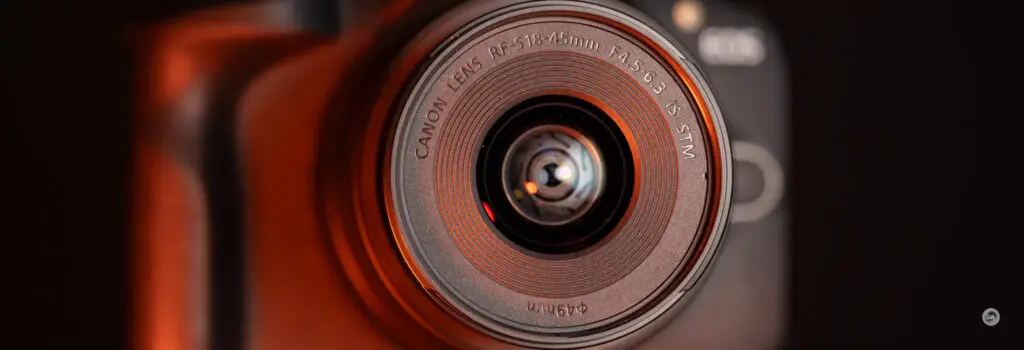
The Canon RF-S 18-45mm F4.5-6.3 IS STM is a cheap and lightweight kit lens for the Canon EOS R10, R50, R100, and future budget mirrorless cameras. It follows in the trend set by the similar EF-M 15-45mm F3.5-6.3 IS STM (now discontinued), though that lens had a slightly advantage in focal length (15mm vs 18mm on the wide end) and a slightly faster maximum aperture of F3.5 vs F4.5 on the wide end. The new RF lens also has a few improvements, however, like better autofocus and better image stabilization. MSRP is $299 for the lens alone or just $120 in kit. The RF-S 18-45mm has a few optical flaws, but also provides good autofocus, good sharpness, and has an image stabilizer for those cameras that lack IBIS (in body image stabilization) like the EOS R50 that I tested it on. Is it worth getting? You can get my findings in the video review here, or keep reading.
Follow Me @ YouTube | Patreon | Instagram | Facebook | DA Merchandise | Flickr | 500px | X
__________________________________________________________________________________________________
Thanks to Camera Canada for sending me a review copy of this lens. As always, this is a completely independent review. All opinions and conclusions are my own. *I have done the majority of these tests on the 24MP Canon EOS R50.
__________________________________________________________________________________________________
Kit lenses need to be jack-of-all-trades, as they will sometimes be the only lens that a person owns. They will typically cover moderately wide (18mm here, or the full frame equivalent of 29mm due to Canon’s 1.6x crop factor) to telephoto (45mm, or the full frame equivalent of 72mm). The RF-S 18-45mm has lens based stabilization (IS), which is important considering that the EOS R50 that I tested it on doesn’t have camera based stabilization. That helps considerably when shooting handheld video and moderately helps to make up for the very slow maximum aperture values available here.
- 18-21mm = F4.5
- 22-30mm = F5
- 31-36mm = F5.6
- 37-45mm = F6.3
If you don’t understand what all of this aperture talk means, just know that this is a lens that is going to do best when there is plenty of light. You might want to supplement this lens with a prime lens with a faster maximum aperture. In decent lighting conditions this lens can make beautiful images.

But is this the best option for you? Dive into the details with me and let’s find out.
Build and Handling
This isn’t a very large zoom range (2.5x), but it does allow enough flexibility to significantly change the framing on a scene. You can go from this at 18mm:

to this at 45mm:

That’s undoubtedly useful, though if you want versatility of zoom range, you should probably consider the much more flexible RF-S 18-150mm F3.5-6.3 IS STM that I reviewed here. It is larger and more expensive, but that extra 105mm means that you might never need to take the lens off the camera! The biggest reason to choose the RF-S 18-45mm seems to be size and weight. The RF-S 18-45mm is just 68.9mm in diameter (2.7″) and is 44.3mm (1.7″) in length. It weighs 130g (4.6oz). Canon’s RF mount has an extremely large diameter for APS-C, so the mount of most of these new RF-S lenses really flares out to accommodate the size of the mount. It gives a slightly odd profile to the RF-S lenses that I don’t particularly like.
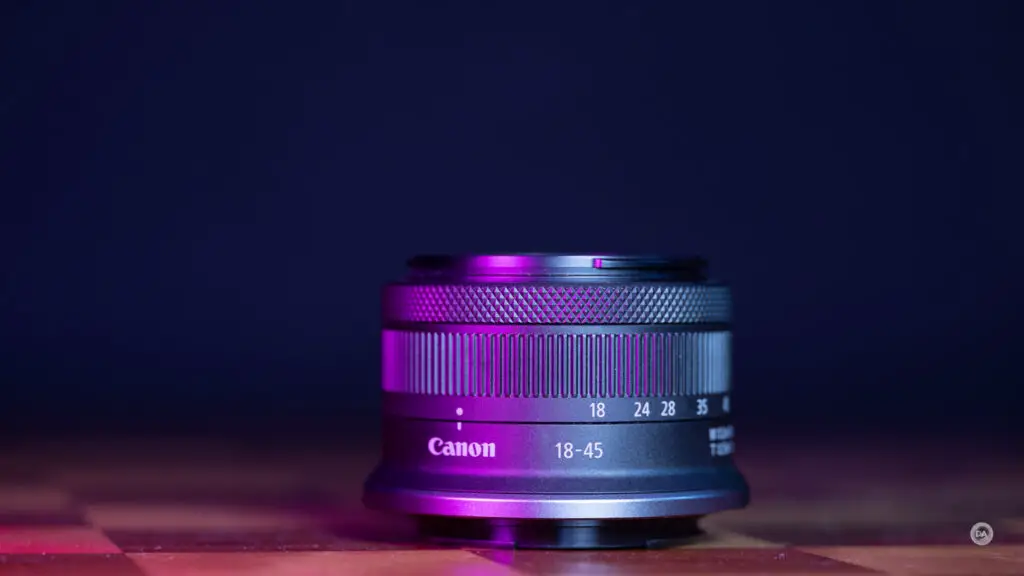
Canon did a great job with the EF-M lenses (and cameras) in giving them some style and a slightly premium feel, but that philosophy does not carry on to the RF-S lenses. This is an extremely “plasticky” feeling lens, and is one of the very rare modern lenses that has a plastic lens mount (I basically only see them on cheap Canon lenses).

The RF-S 18-45mm achieves its smaller size in part by being a retractable zoom. It is less than 45mm for storage, but is unusable in that form.
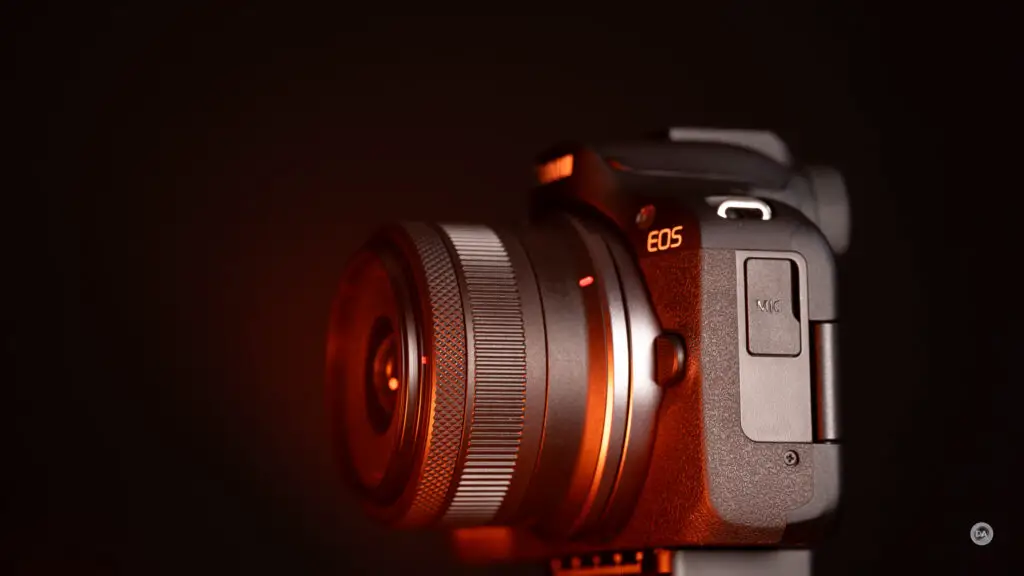
On screen will be a warning to “Set the lens to the shooting position”, as the lens is incapable of proper focus in the retracted position.

While doing a bit of research on the Canon site I found that the most negative reviews were from people who saw this screen but didn’t know what it meant. They were unable to take photos with their new lens and were very frustrated. And, to be fair, if you aren’t familiar with retractable zooms you will be surprised by how much force it takes to twist the zoom ring (that feels like it is locked) into the 18mm shooting position. It isn’t a very refined process.
The inner barrel will extend a significant amount (almost 27mm) to achieve the 18mm shooting position. Once extended, this is a “rocker” style zoom that is longest at 18mm, shortest near 28mm, then extends back out at 45mm, though not as far as at 18mm. I don’t love rocker type zoom action.

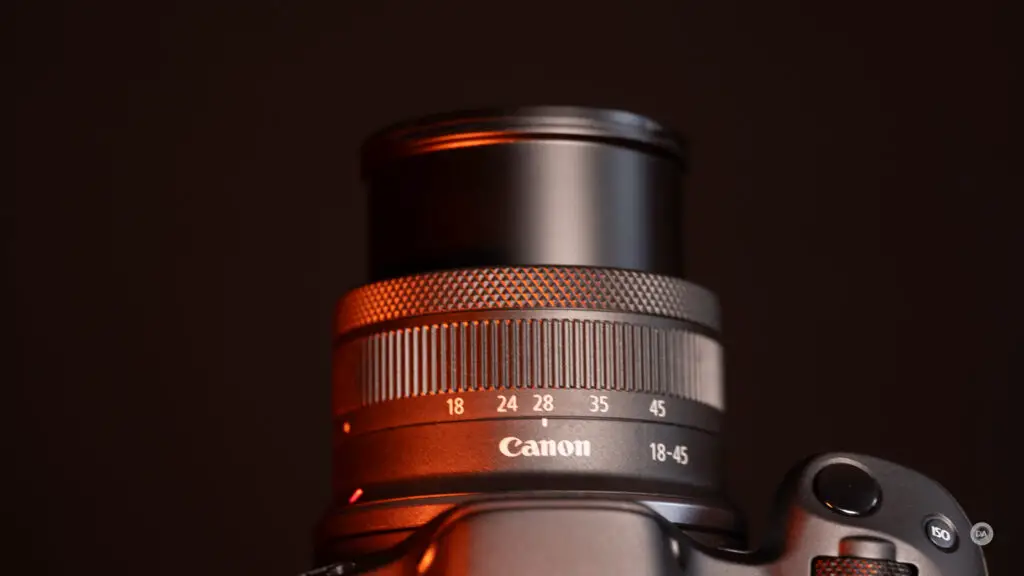
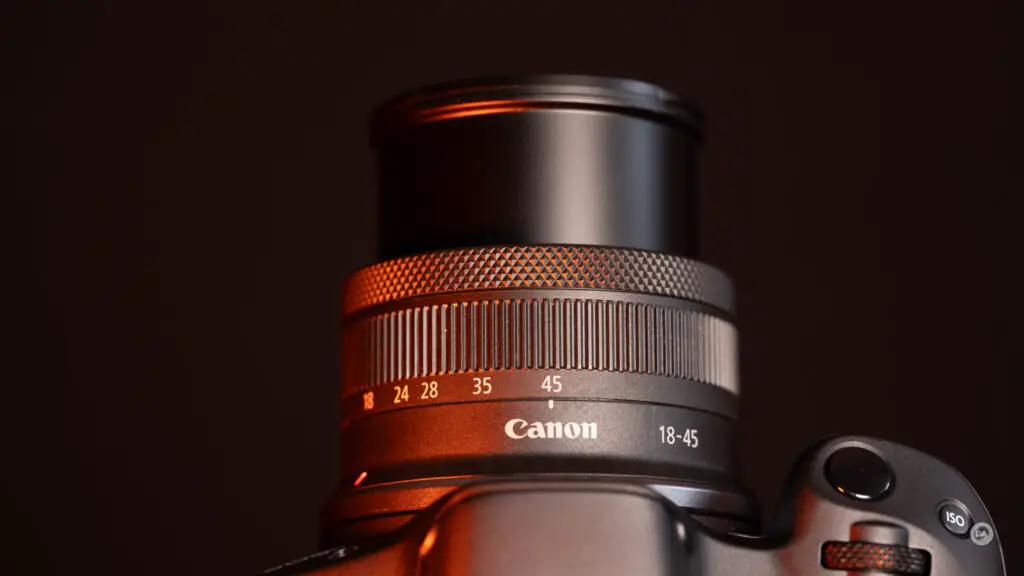
There are two rings on the lens. The larger is the zoom ring. It moves okay (though not as nicely as I would like when making fine zooming motions), but the action to either retract the lens or extend it from retraction feels clunky. The second ring is the control ring.

The two rings are close together, but the unique diamond texture of Canon’s control rings helps set it apart by feel. It’s a consistent touch on Canon’s lenses that I enjoy.
The control ring can serve as a control point whose function can be assigned from within the camera. It could be an aperture ring, Exposure Compensation, or any number of other things, though the default function here is as a manual focus ring. The manual focus action is lighter than what I would like and doesn’t have the precision of the similar ring on the RF 24-50mm that I tested at the same time.
Also unlike the RF 24-50mm is a completely lack of buttons on the side of the lens. You’ll have to control AF/MF switching from within the camera body.

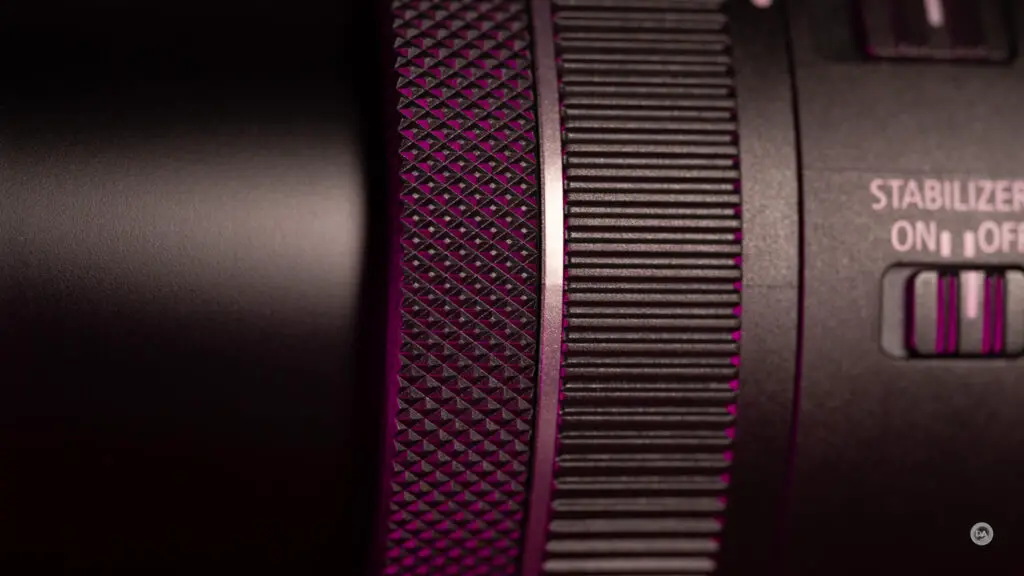
The lens has a matte finish with a few platinum colored accent rings that marry nicely to the similar color on the lens mount of the camera.
As is standard for Canon’s non L-series lenses, the lens hood is not included and there is no weather sealing. It’s an increasingly non-competitive policy when lenses that cost less than $100 regularly come with lens hoods. The Canon spec EW-53 lens hood is a $29 accessory, which is ridiculous when it costs pennies to produce. Here’s a link to a $10 Vello hood instead.
The aperture iris has 7 rounded blades and does a reasonable job of maintaining a circular shape as the lens is stopped down.

Up front we have a common 49mm front filter thread.

The highest magnification here comes on the telephoto end where it can focus as closely as 45cm (11.8″) and produces a 0.16x magnification. You can manually focus closer, however, and by doing so increase the magnification as high as 0.26x as shown here.
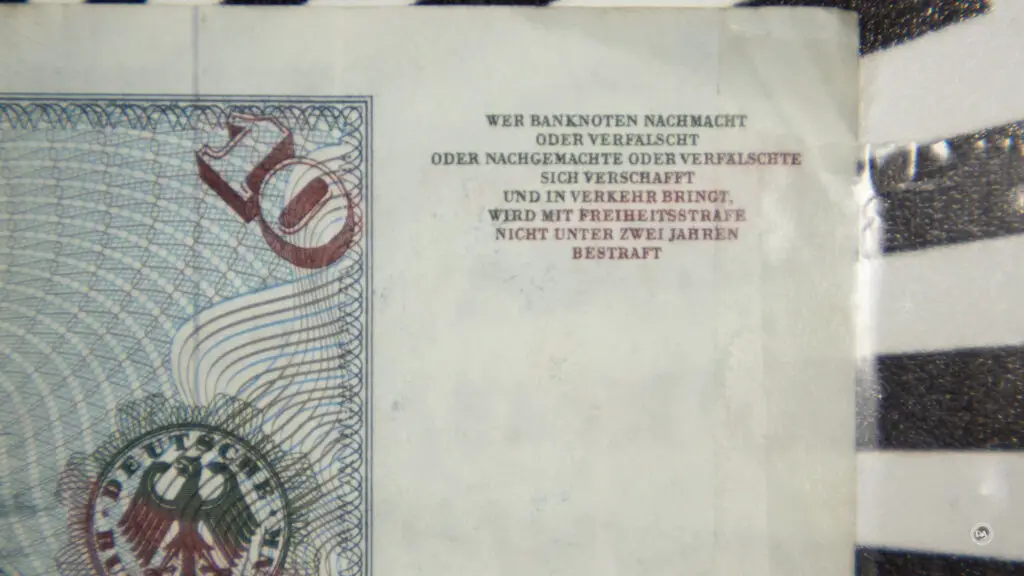
That’s a more useful figure, though you can see that at this focus distance contrast is pretty strongly reduced.
The IS (Image Stabilization) system here is rated for 4 stops of assistance and up to 6 stops when used in conjunction with a camera equipped with IBIS. I primarily tested it on the Canon EOS R50 (no IBIS), and found that I was able to get stable handheld video footage along with some assistance with handholding lower shutter speeds for stills, though I find there’s always a practical limit to how long you can go before you get some shake.
The build and handling here are largely what I would expect. It’s an inexpensive lens that feels rather cheap, but gets the job done. Canon’s typical cost cutting measures with their non-L lenses are annoying, but nothing that is unique to this particular lens.
Autofocus and Video
Canon utilizes a lead-screw type STM (stepping motor) here, and it is a pretty solid implementation. Autofocus speed is quick and (mostly) quiet, with some minor whines during major focus changes. I heard little noise for stills, but did hear a bit more of the whine when doing video focus pulls.
I found that my focus speed was fairly snappy, though my indoors test revealed a completely unnecessary defocus between two focus subjects that slowed focus a bit. I didn’t see that issue outside in better light. Very low lighting conditions will slow focus down a bit further, though Canon’s robust AF systems in their cameras do a reasonable job of covering for the lens and its low light gathering potential.
Focus accuracy was good. I shot some images of Nala rolling around, and each of the photos was accurately focused.


This shot of spring buds also shows accurate focus even as the branches waved around in the breeze.

I really liked the focus motor’s performance during my focus pulls. There was a high degree of confidence, and rather than snapping back and forth the focus pulls are smooth and well damped. I would say that this lens is perhaps more useful for video than it is for stills in many ways.
This is a lens that would work well as a gimbal lens. It’s small, lightweight, focuses well, and could work for gimbals or vlogging.
My hand test (where I alternately block the lens’ view of my face with my hand and then remove it) also went well so long as I gave the lens time to make its more sedate transitions. Focus breathing is fairly minimal.
All in all, focus is solid here. That’s a definite strength for the lens.
Image Quality Breakdown
The RF-S 18-45mm sports a simple optical formula of 7 elements in 7 groups, and this includes two aspherical elements. Canon has shown a tendency to rely more on electronic rather than optical corrections in a number of their wide angle lenses, and we’ll see that unfortunate trend continue here.
In optimal conditions the RF-S is capable of producing nice looking images, though it isn’t very flexible around the edges because of its design limitations.

Starting with vignette and distortion. If you look at a corrected JPEG or RAW file, things don’t look too bad at 18mm.
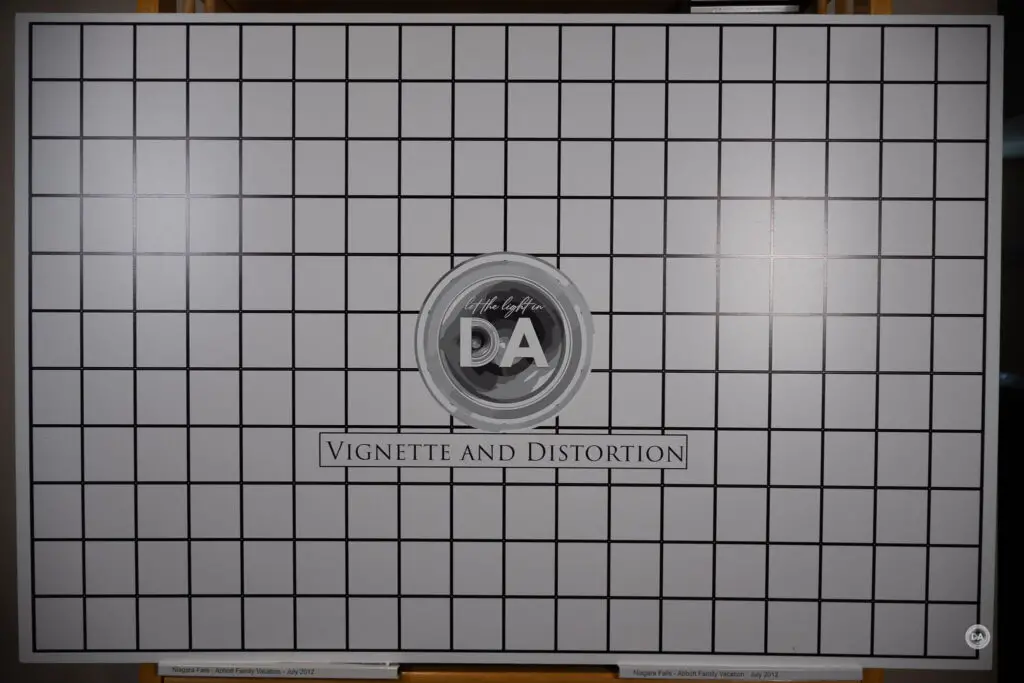
But, as I mentioned, this is almost exclusively electronic correction. Here is what the uncorrected image looks like:
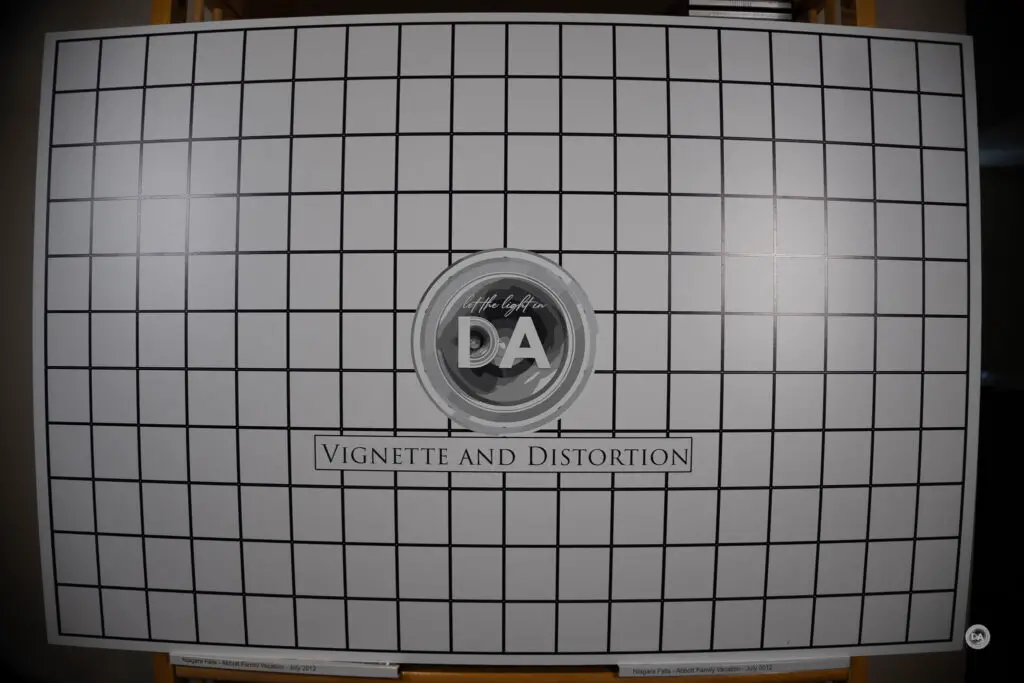
Now fortunately this isn’t nearly as bad as the extremes I saw on the RF 24-50mm, but you can see that once again Canon has had to leave a lot of extra room to allow for the distortion to be corrected. There is so much distortion that Canon is having to design their lenses much wider than the stated focal length so that the electronic correction can try to bring it back to a semblance of normal. If I manually correct the distortion to test the amount present, I had to use a +35 to correct it all. I then would have to crop even further to get to the framing that I had on screen (I framed with the outside lines of the test chart up against the edges of the frame on the LCD).
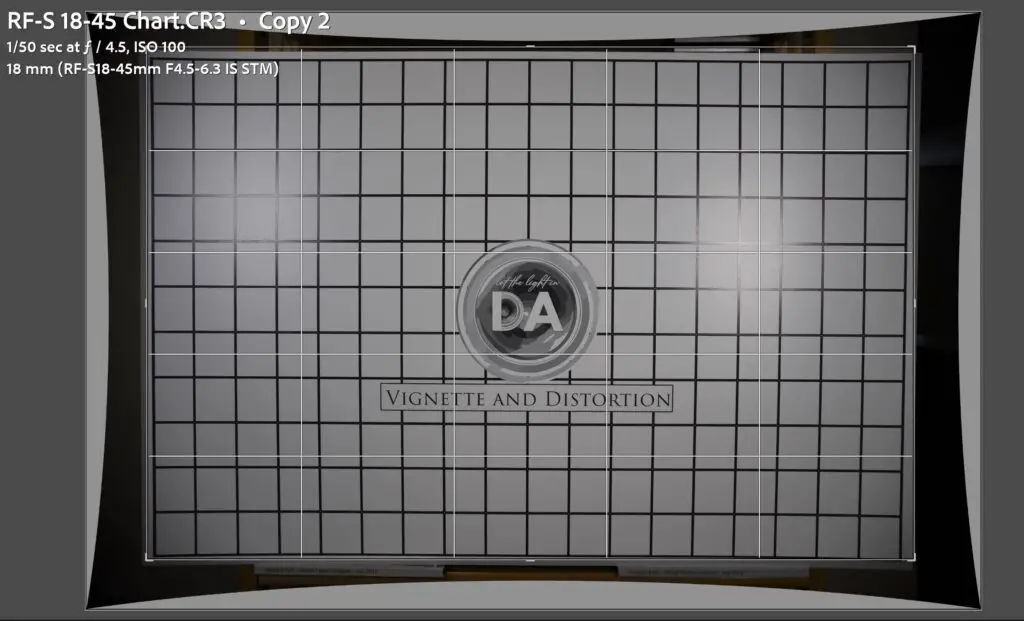
I had to be fairly aggressive with the vignette slider as well, as it took a +83 to correct the vignette, or about 3 stops in the corners. Fortunately the corrections are much more minimal as you move through the zoom range, with far less vignette and distortion to correct for.
In camera or in Canon DPP software you don’t even have the option of disabling the corrections…and you can see why. Software is doing a LOT of the heavy lifting here…and maybe you care about that, or maybe you don’t.
Longitudinal chromatic aberrations (LoCA) are less common on a lens with such a small maximum aperture, but I can see some green fringing if I work to shoot for it.

Likewise there is some lateral chromatic aberrations (LaCA) near the edge of the frame, but nothing that can’t be easily fixed by corrections.

So how about resolution and contrast? I’ve tested this lens on the 24 MP EOS R50 that it came in kit with. Here’s the test chart:
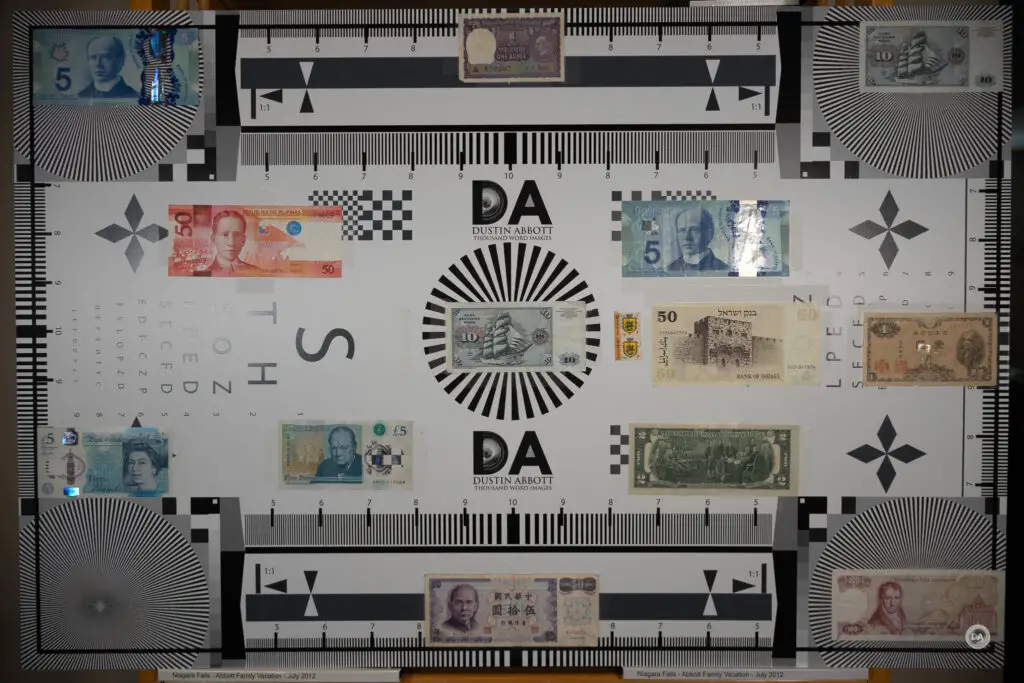
You will note that the test chart looks a little “dingy” despite profile corrections. Those correction profiles can’t hide the fact image quality is less than pristine here.
Here are the roughly 200% crops from across the frame at 18mm, F4.5.


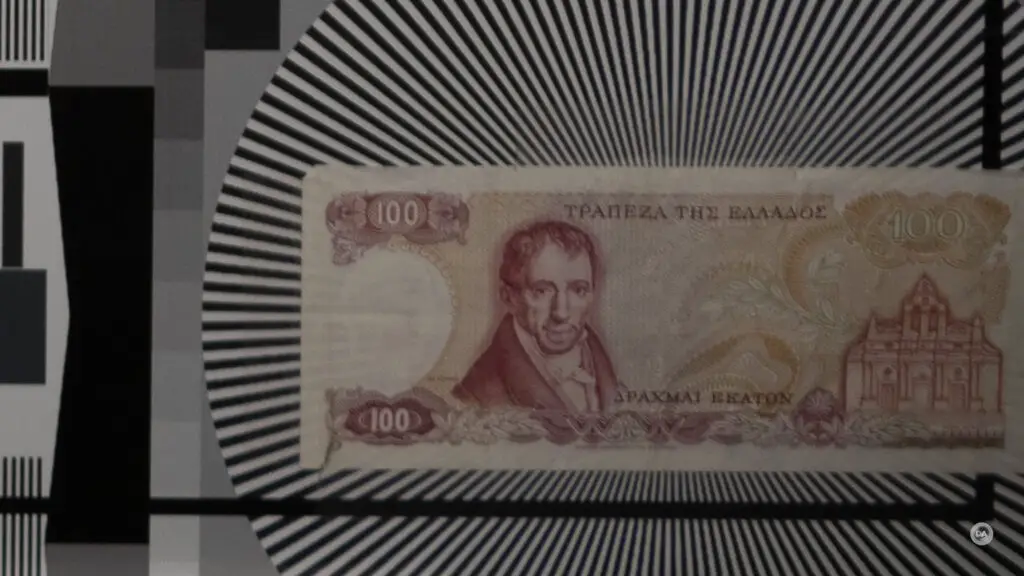
Resolution looks good in the center and mid-frame, but there is some obvious softening in the corners. The copy I tested showed good centering and consistent results on both sides.
Stopping down to F5.6 and F8 does show some improvement across much of the frame, but the corners never really sharpen up too much, though they do brighten due to some improved contrast and reduced vignette.

Real world landscape images at F5.6 and F8 look fine, though the corners aren’t fantastic.



F11 looks largely the same, but after F11 the image will slightly soften due to the effects of diffraction. Expect this impact to be much higher if you use a higher resolution camera like the EOS R7.

Things are slightly improved at 24mm. The center and midframe don’t look much different, but the corners are much better.
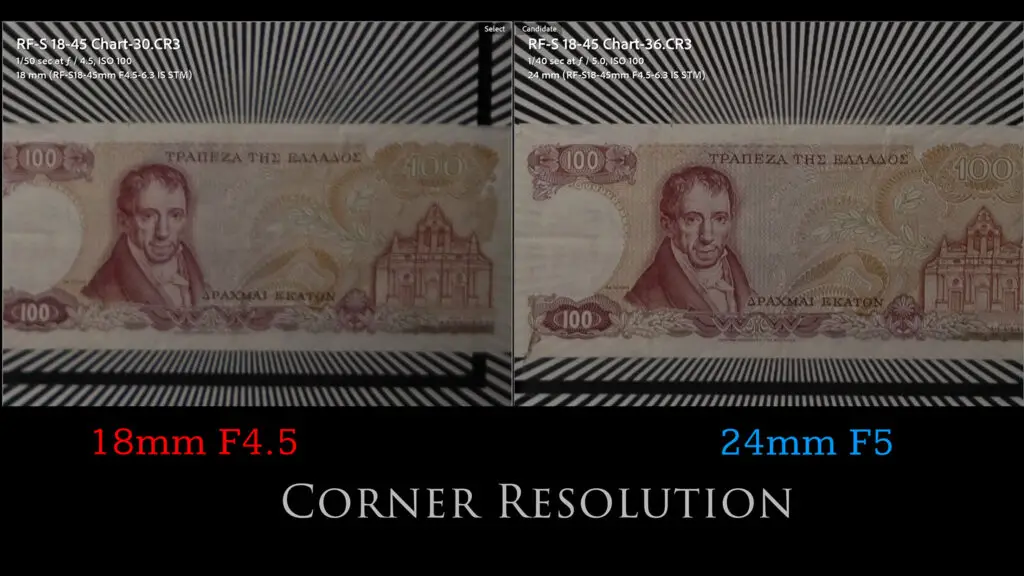
There’s a slight bit more total improvement as you stop the lens down at 24mm, with a practical limit hit by F8.
35mm is fairly similar, though the corners have regressed again. I found the best corner results came at F11, which look okay but not pin sharp.
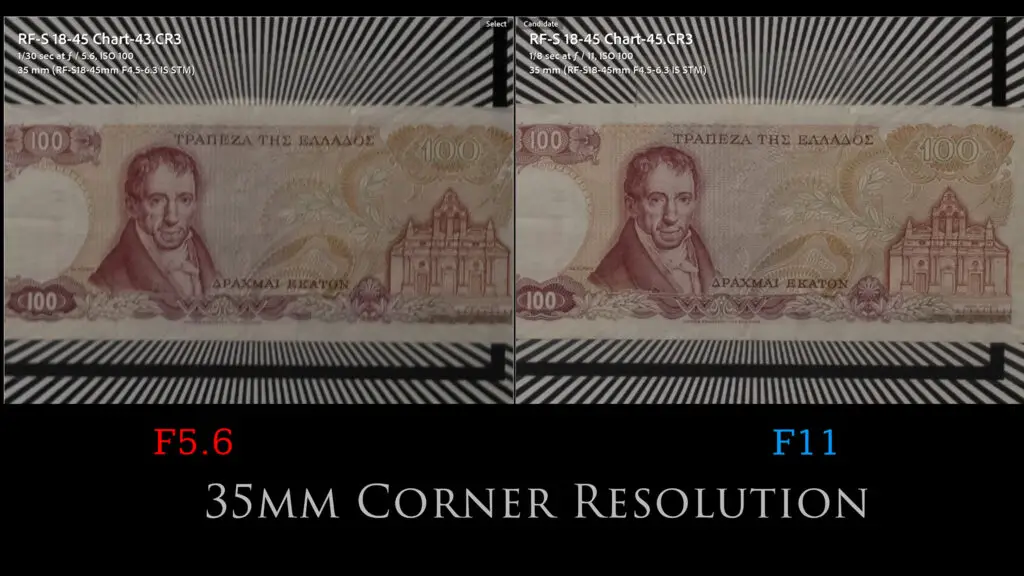
45mm is a little softer than 35mm, and the fact that maximum aperture is now F6.3 means that it gets harder to stop the lens down to achieve more sharpness. It’s one thing if slow lenses like this are razer sharp wide open, but another altogether if they aren’t particularly sharp. F8 was about as good as I saw, but it wasn’t fantastic.

In optimal lighting, however, real world images looked pretty good.
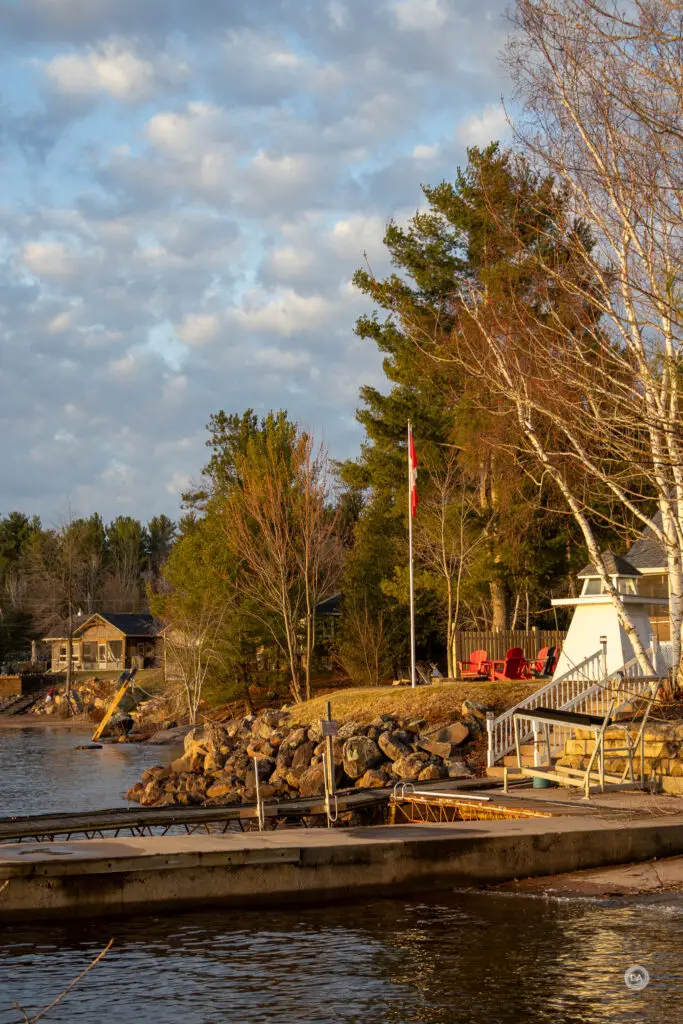

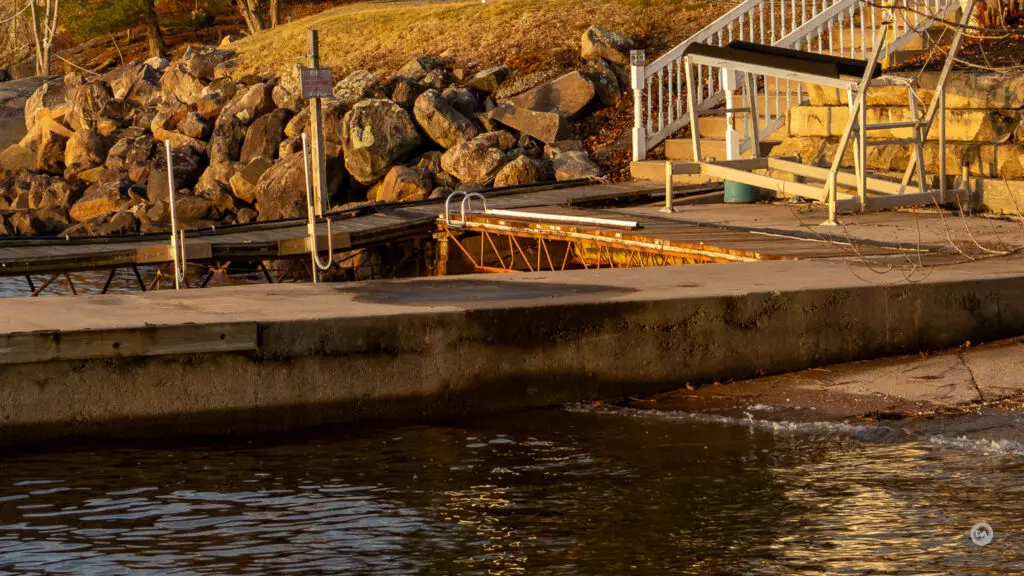
This real world shot of Nala also looked pretty crisp.


Obviously the corners largely leave me wanting, but for the money this lens isn’t too bad in terms of sharpness.
Flare resistance was pretty good. I shot into the sun a number of times and never saw too much damage on than a little sun spot in the lower left corner of this image.

I had fairly low expectations for bokeh with a lens like this. It has little capacity for producing much subject separation, as the maximum aperture is small, the minimum focus distance is fairly long, and the maximum focal length is only 45mm. That leaves quite a bit in focus at all times, and even being just a few feet away from this boat and shooting at 45mm, F6.3, you can see that nothing is strongly out of focus.

If you can get right on top of your subject and background is reasonably far away, you can produce a bit of blur.

If producing bokeh is your priority, then skip this lens and buy the inexpensive RF 50mm F1.8. Here’s a gallery with more photos.
There isn’t really anything that stands out about the optical performance here other than the strong vignette and distortion, but it is very rare when a kit lens like this impresses. It is the definition of “jack of all trades, master of none.”
Conclusion
The Canon RF-S 18-45mm F4.5-6.3 IS STM serves a specific purpose, namely to provide a small, lightweight, inexpensive lens for people to add to their new mirrorless camera so that they have a lens to actually take pictures with. There will be plenty of people who buy an R100 or R50 and never buy another lens other than this one, not realizing that these days a lens is more likely to hold a camera back than the other way around. This is the kind of lens that can take pretty decent images in optimal situations, but doesn’t really bring much in terms of optical excellent to the table.

The RF-S 18-45mm has pretty good autofocus, a useful image stabilizer, and might make the most sense as a lightweight video lens for handheld video, or, better still, use on a gimbal.

But if you are interested in a one lens solution, it might make more sense to save your money and invest in the Canon RF-S 18-150mm F3.5-6.3 IS STM lens, as it provides much more versatility. And yes, it is larger, but at 310g it is still reasonably light. The retractable zoom style of the RF-S 18-45mm makes the most sense for the person who wants to be able to carry their camera in some kind of small case (a fanny pack style case, for example), and they need as small of a profile as possible. But unless you fit the scenarios I’ve described, you can certainly choose better optical instruments for your camera.
Pros:
- Has IS
- Compact and lightweight
- Good autofocus performance
- Decently sharp throughout the zoom range
- Good flare resistance
- Video focus is fairly smooth
Cons:
- Zoom ring can be a little stiff
- Heavy vignette and distortion at 18mm
- Retractable zoom transition is clunky
- No hood included
- Corners are mostly soft
_________________________________________________________________________
GEAR USED:
Purchase the Canon RF-S 18-45mm IS @ Camera Canada | B&H Photo | Adorama | Amazon | Amazon Canada | Amazon UK | Amazon Germany
_______________________________________________________________
Purchase the Canon EOS R50 @ Camera Canada | B&H Photo | Adorama | Amazon | Amazon Canada | Amazon UK | Amazon Germany
___________________________________________________________________
_________________________________________________________________
Want to support this channel? Use these affiliate links to shop at: B&H Photo | Amazon | Adorama | Camera Canada | Amazon Canada | Amazon UK | Ebay | Make a donation via Paypal
Buy DA Merchandise https://bit.ly/TWIMerch
Keywords: RF-S 18-45mm, Canon RF-S 18-45mm, 18-45mm, F4.5-6.3, IS, STM, Canon RF 18-45mm F4.5-6.3 IS STM, Canon EOS R50, EOS, R, R50, Review, M50, APS-C, RF, mirrorless, Sports, Tracking, Dustin Abbott, Real World, Comparison, Handling, Focus, Portraits, Resolution, High ISO, Image Quality, Sample Images, Photography, 45MP, 24MP, Canon, #letthelightin, #DA, #EOSR50
DISCLAIMER: This article and description contains affiliate links, which means that if you click on one of the product links, I’ll receive a small commission. As an Amazon Associate I earn from qualifying purchases.










 Sirui Sniper 75mm F1.2 Review
Sirui Sniper 75mm F1.2 Review  Sirui Sniper 75mm F1.2 Gallery
Sirui Sniper 75mm F1.2 Gallery  Tamron 70-300mm F4.5-6.3 RXD Z-mount Review
Tamron 70-300mm F4.5-6.3 RXD Z-mount Review  Nikkor Z 40mm F2 Review
Nikkor Z 40mm F2 Review 





